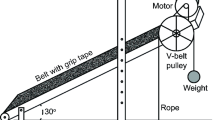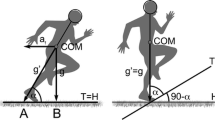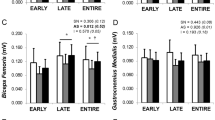Abstract
Kinematic and electromyography (EMG) aspects of running on a firm surface and on soft, dry sand were studied to elucidate mechanisms contributing to the higher energy cost (EC) of sand running. Eight well-trained males (mean \(\dot V{\text{O}}_{2\max } \) 64.3±8.6 ml·kg−1·min−1) performed barefoot running trials on a firm surface (wooden floor) and on a soft, dry sand surface (track dimensions 8.8 m×60 cm; depth 13 cm) at 8 and 11 km·h−1. Kinematic and EMG data were collected simultaneously using an integrated six-camera 50 Hz VICON motion analysis system, an AMTI force-plate and a 10-channel EMG system. Running at 8 km·h−1 on sand resulted in a greater (P<0.05) stance time (ts) compared with the firm surface. At 11 km·h−1, sand running resulted in a greater stance-to-stride ratio (P<0.005), a shorter stride length (SL) (P<0.05), and a greater cadence (P<0.001) compared with the firm surface values. Hip and knee flexion at initial foot contact (IFC), mid-support (MS) and flexion maximum were greater (P<0.001) running on sand compared with firm surface values at 8 and 11 km·h−1. Over duration of stride, Hamstring (semimembranosus and biceps femoris) EMG was greater running on sand compared with the firm surface at 8 (P<0.001) and 11 (P<0.05) km·h−1. During the stance phase in the 8-km·h−1 trials, EMG in the Hamstrings (P<0.001), Vastii (Vastus lateralis and Vastus Medialis) (P<0.02), Rectus femoris (Rec Fem) (P<0.01) and Tensor Fascia Latae (Tfl) (P<0.0001) were greater than the firm surface measures. During stance in the 11-km·h−1 trials, Tfl EMG was greater (P<0.02) running on sand compared with the firm surface. At IFC and MS, Hamstrings’ EMG was greater on sand at both running speeds (P<0.001). For the Vastii (P<0.02), Rec Fem (P<0.0001) and Tfl (P<0.0001) muscles, the EMG at MS running on sand at both speeds was greater than the firm surface values. The increased EC of running on sand can be attributed in part to the increased EMG activation associated with greater hip and knee range of motion compared with firm surface running.







Similar content being viewed by others

References
Berger D (1980) Early season sand training. Harrier 7(1):6
Besier TF, Lloyd DG, Cochrane JL, Ackland TR (2001) External loading of the knee joint during running and cutting maneuvers. Med Sci Sports Exerc 33(7):1168–1175
Buczek FL, Cavanagh PR (1990) Stance phase knee and ankle kinematics and kinetics during level and downhill running. Med Sci Sports Exerc 22(5):669–677
Cappozzo A, Catani F, Della Croce, U. and Leardini, A. (1995). Position and orientation in space of bones during movement: anatomical frame definition and determination. Clin Biomech 10(4):171–178
Cavanagh PR, Kram R (1990) Stride length in distance running: velocity, body dimensions and added mass effects. In: Peter R. Cavanagh (ed) Biomechanics of distance running. Human Kinetics Books, Champaign, pp 35–63
Clegg B (1978) An impact soil test for low cost roads. In: Proceedings of 2nd conference of the road engineering association of Asia and Australia, Manila, pp 58–65
Clegg B (1980) An impact soil test as an alternative to California bearing ratio. In: Third ANZ geomechanics conference, vol 1. Wellington, New Zealand, pp 225–230
De Wit B, De Clercq D (2000) Timing of lower extremity motions during barefoot and shod running at three velocities. J Appl Biomech 16:169–179
De Wit B, De Clercq D, Aerts P (2000) Biomechanical analysis of the stance phase during barefoot and shod running. J Biomech 33:269–278
Delagi EF, Perotta A (1980) Anatomical guide for the electromyographer: the limbs, 2nd edn. Charles C. Thomas, Springfield
Dillman CJ (1975) Kinematic analysis of running. Exerc Sports Sci Rev 3:193–218
Elliott BC, Blanksby BA (1976) A cinematographic analysis of overground and treadmill running by males and females. Med Sci Sports 8(2):84–87
Fukunaga T, Kubo K, Kawakami Y, Fukashiro S, Kanehisa H, Maganaris CN (2001) In vivo behaviour of human muscle tendon during walking. Proc R Soc Lond B 268:229–233
Grillner S, Halbertsma J, Nilsson J, Thorstensson A. (1979) The adaptation to speed in human locomotion. Brain Res 165:177–182
Jammes Y, Caquelard F, Badier M. (1998). Correlation between surface electromyogram, oxygen uptake and blood lactate concentration during dynamic leg exercise. Respir Physiol 112:167–174
Kinoshita H., Fujii N, Fukuda H (1988) Response of the lower extremity muscles to varied cushioning properties of the foot/ground interface during running. In: de Groot G, Hollander AP, Huijing PA, van Ingen Schenau GJ (eds) Biomechanics X1-B. Free University Press, Amsterdam, pp 660–667
Kleissen RFM, Buurke JH, Harlaar J, Zilvold G (1998) Electromyography in the biomechanical analysis of human movement and its clinical application. Gait and Posture 8:143–158
Kram R, Taylor CR (1990) Energetics of running: a new perspective. Nature 346:265–267
Kubo K, Kawakami Y, Fukunaga T (1999) Influence of elastic properties of tendon structures on jump performance in humans. J Appl Physiol 87(6):2090–2096
Kyrolainen H, Belli A, Komi P (2001) Biomechanical factors affecting running economy. Med Sci Sports Exerc 33(8):1330–1337
Leardini A, Cappozzo A, Catani F, Toksvig-Larsen S, Petitto A, Sforza V, Cassanelli G, Giannini S (1999) Validation of a functional method for the estimation of hip joint centre location. J Biomech 32:99–103
Lejeune TM, Willems PA, Heglund NC (1998) Mechanics and energetics of human locomotion on sand. J Exp Biol 201:2071–2080
Lloyd DG, Buchanan TS (2001) Strategies of the muscular support of static varus and valgus loads at the human knee. J Biomech 34(10):1257–1267
Mann RA, Hagy J (1980a) Biomechanics of walking, running and sprinting. Am J Sports Med 8(5):345–350
Mann RA, Hagy J (1980b) Running, jogging, and walking: a comparative electromyographic and biomechanical study. In: Bateman JE, Trott AW (eds) The foot and ankle, American Orthopaedic Foot Society. Thieme-Stratton, New York, pp 167–175
Mann RA, Moran GT, Dougherty SE (1986) Comparative electromyography of the lower extremity in jogging, running, and sprinting. Am J Sports Med 14(6):501–510
McClay IS, Lake MJ, Cavanagh PR (1990) Muscle activity in running. In: Peter R Cavanagh (ed) Biomechanics of distance running. Human Kinetics Books, Champaign, pp 165–186
McMahon TA, Greene PR (1979) The influence of track compliance on running. J Biomech 12:893–904
McMahon TA, Valiant G, Frederick EC (1987) Groucho running. J Appl Physiol 62(6):2326–2337
McNair PJ, Marshall RN (1994) Kinematic and kinetic parameters associated with running in different shoes. Br J Sports Med 28(4):256–260
Milliron MJ, Cavanagh PR (1990) Sagittal plane kinematics of the lower extremity during distance running. In: Peter R. Cavanagh (ed) Biomechanics of distance running. Human Kinetics Books, Champaign, pp 65–99
Munro CF, Miller DI, Fuglevand AJ (1987) Ground reaction forces in running: a reexamination. J Biomech 20(2):147–155
Nilsson J, Thorstensson A, Halbertsma J (1985). Changes in leg movements and muscle activity with speed of locomotion and mode of progression in humans. Acta Physiol Scand 123:457–475
Novacheck TF (1998) The biomechanics of running. Gait Posture 7:77–95
Oviatt R, Hemba G (1991) Oregon state: sandblasting through the PAC. National Strength and Conditioning Association Journal 13(4):40–46
Pare EB, Stern Jr JT, Schwartz JM (1981) Functional differentiation within the Tensor Fasciae Latae. J Bone Joint Surg 63-A(9):1457–1471
Piazza SJ, Okita N, Cavanagh PR (2001). Accuracy of the functional method of hip joint centre location: effects of limited motion and varied implementation. J Biomech 34:967–973
Pinnington HC, Dawson B (2001a) The energy cost of running on grass compared to soft dry beach sand. J Sci Med Sport 4(4):416–43
Pinnington HC, Dawson B (2001b) Running economy of elite surf iron men and male runners, on soft dry beach sand and grass. Eur J Appl Physiol 86(1):62–70
Roberts TJ, Kram R, Weyland PG, Taylor CR (1998) Energetics of bipedal running: 1. Metabolic cost of generating force. J Exp Biol 201:2745–2751
Shorten MR (1987) Muscle elasticity and human performance. Med Sport Sci 25:1–18
The International Society of Biomechanics (1995) Standardization and terminology in biomechanics, vol 1.
Wank V, Frick U, Schmidtbleicher D (1998) Kinematics and electromyography of lower limb muscles in overground and treadmill running. Int J Sports Med 19:455–461
Williams KR (1985) Biomechanics of running. Exerc Sports Sci Rev 13:389–441
Williams KR, Cavanagh PR (1987) Relationship between distance running mechanics, running economy, and performance. J Appl Physiol 63(3):1236–1245
Wilson GJ, Elliott BC, Wood GA. (1991) The effect on performance of imposing a delay during a stretch-shorten cycle movement. Med Sci Sports Exerc 23(3):364–370
Wischnia B (1982) Beach running. Runner’s World 17(7):48–49, 76
Woltring HJ (1986) A Fortran package for generalized, cross-validatory, spline smoothing and differentiation. Adv Eng Softw 8:104–113
Zamparo P, Perini R, Orizio C, Sacher M, Ferretti G (1992) The energy cost of walking or running on sand. Eur J Appl Physiol 65:183–187
Author information
Authors and Affiliations
Corresponding author
Rights and permissions
About this article
Cite this article
Pinnington, H.C., Lloyd, D.G., Besier, T.F. et al. Kinematic and electromyography analysis of submaximal differences running on a firm surface compared with soft, dry sand.. Eur J Appl Physiol 94, 242–253 (2005). https://doi.org/10.1007/s00421-005-1323-6
Received:
Accepted:
Published:
Issue Date:
DOI: https://doi.org/10.1007/s00421-005-1323-6



